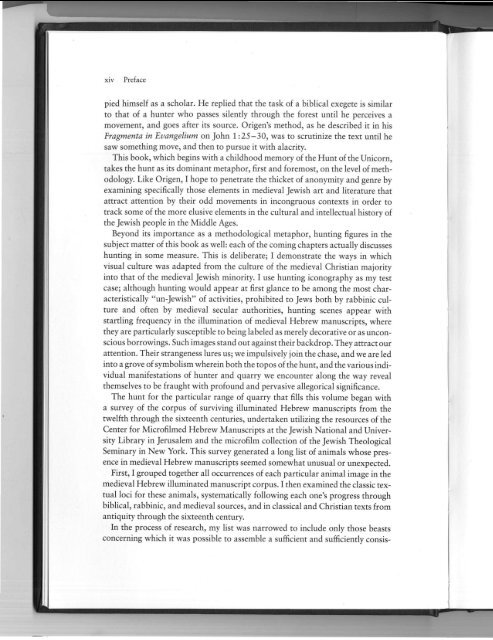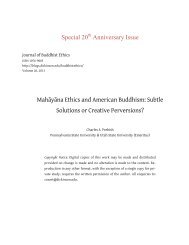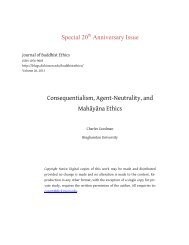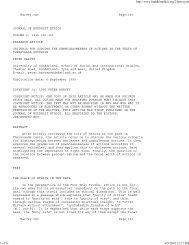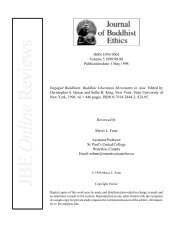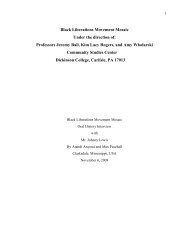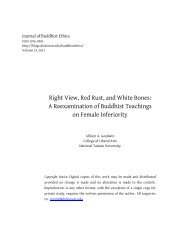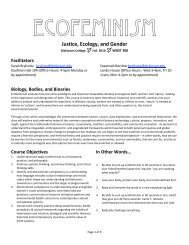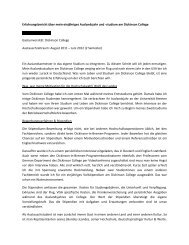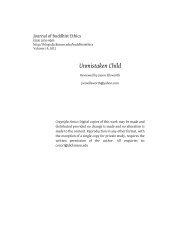Epstein, Dreams of Subversion INTRO ... - Dickinson Blogs
Epstein, Dreams of Subversion INTRO ... - Dickinson Blogs
Epstein, Dreams of Subversion INTRO ... - Dickinson Blogs
Create successful ePaper yourself
Turn your PDF publications into a flip-book with our unique Google optimized e-Paper software.
XIV Preface<br />
pied himself as a scholar. He replied that the task <strong>of</strong> a biblical exegete is similar<br />
to that <strong>of</strong> a hunter who pass es silently through the forest until he perceives a<br />
movement, and goes after its source. Origen's method, as he described it in his<br />
Fragmenta in Evangelium on John 1 :25-30, was to scrutinize the text until he<br />
saw something move, and then to pursue it with alacrity.<br />
This book, which begins with a childhood memory <strong>of</strong> the Hunt <strong>of</strong> the Unicorn,<br />
takes the hunt as its dominant metaphor, first and foremost, on the level <strong>of</strong> methodology.<br />
Like Origen, I hope to penetrate the thicket <strong>of</strong> anonymity and genre by<br />
examining specifically those elements in medieval Jewish art and literature that<br />
attract attention by their odd movements in incongruous contexts in order to<br />
track some <strong>of</strong> the more elusive elements in the cultural and intellectual history <strong>of</strong><br />
the Jewish people in the Middle Ages.<br />
Beyond its importance as a methodological metaphor, hunting figures in the<br />
subject matter <strong>of</strong> this book as well: each <strong>of</strong> the coming chapters actually discusses<br />
hunting in some measure. This is deliberate; I demonstrate the ways in which<br />
visual culture was adapted from the culture <strong>of</strong> the medieval Christian majority<br />
into that <strong>of</strong> the medieval Jewish minority. I use hunting iconography as my test<br />
case; although hunting would appear at first glance to be among the most characteristically<br />
"uri-jewish" <strong>of</strong> activities, prohibited to Jews both by rabbinic culture<br />
and <strong>of</strong>ten by medieval secular authorities, hunting scenes appear with<br />
startling frequency in the illumination <strong>of</strong> medieval Hebrew manuscripts, where<br />
the y are particularly susceptible to being labeled as merely decorative or as unconscious<br />
borrowings. Such images stand out against their backdrop. The y attractour<br />
attention. Their strangeness lures us; we impulsively join the chase, and we are led<br />
into a grove <strong>of</strong> symbolism wherein both the topos <strong>of</strong> the hunt, and the various individual<br />
manifestations <strong>of</strong> hunter and quarry we encounter along the way reveal<br />
themselves to be fraught with pr<strong>of</strong>ound and pervasive allegorical significance.<br />
The hunt for the particular range <strong>of</strong> quarry that fills this volume began with<br />
a survey <strong>of</strong> the corpus <strong>of</strong> surviving illuminated Hebrew manuscripts from the<br />
twelfth through the sixteenth centuries, undertaken utilizing the resources <strong>of</strong> the<br />
Center for Micr<strong>of</strong>ilmed Hebrew Manuscripts at the Jewish National and University<br />
Library in Jerusalem and the micr<strong>of</strong>ilm collection <strong>of</strong> the Jewish Theological<br />
Seminary in New York. This surve y generated a long list <strong>of</strong> animals whose presence<br />
in medieval Hebrew manuscripts seemed somewhat unusual or unexpected.<br />
First, I grouped together all occurrences <strong>of</strong> each particular animal image in the<br />
medieval Hebrew illuminated manuscript corpus. I then examined the classic textualloci<br />
for these animals, systematically following each one's progress through<br />
biblical, rabbinic, and medieval sources, and in classical and Christian texts from<br />
antiquity through the sixteenth century.<br />
In the process <strong>of</strong> research, my list was narrowed to include only those beasts<br />
concerning which it was possible to assemble a sufficient and sufficiently consis-<br />
Preface xv<br />
tent body <strong>of</strong> corroborative textual or iconographic evidence. A good many highly<br />
interesting examples were eliminated from the list because the gaps in the corroborative<br />
materials were too wide to bridge, even with well-grounded speculation.<br />
Some <strong>of</strong> those cases are tr eated in the notes to this volume .<br />
Ne xt, my focu s shifted to a survey <strong>of</strong> the iconographic representations <strong>of</strong> the<br />
selected animals in ancient art an d in med ieval Christian art , with particular attention<br />
to examples contemporary with or closely antecedent to the Jewish images.<br />
Finally, I reexamined the examples <strong>of</strong> animal imagery I had culled from<br />
medieval Hebrew illuminated manuscripts, applying the evidence gathered about<br />
the place <strong>of</strong> each beast in medieval mentalites to the iconography that had previously<br />
seemed strange or incongruous in Jewish art, in order to develop a reasonable<br />
and textually grounded explanation for its inclu sion in Jewish iconography.<br />
Chapters 2 through 5 pre sent the results <strong>of</strong> the se labors, describing the origins,<br />
development, and contextual significance <strong>of</strong> four specific animal symbols,<br />
each <strong>of</strong> which addresses a major are a <strong>of</strong> medieval Jewish rnentalites: national selfimage,<br />
the image <strong>of</strong> the Torah, God and the problem <strong>of</strong> evil, and messiani sm and<br />
eschatology.<br />
In the process <strong>of</strong> working on these chapters, I found my thinking concerning<br />
the ostensible consciousness or unconsciouness <strong>of</strong> this iconography evolving as I<br />
developed, questioned, mulled over, and reworked my interpretations and was<br />
questioned by others about them. The first and final chapters, the result <strong>of</strong> these<br />
ruminations, discuss general problems <strong>of</strong> Jewish art and the place <strong>of</strong> animal iconography<br />
in it. They argue that animal symbols, beyond their inherent fascination,<br />
are <strong>of</strong> intrinsic value for the construction <strong>of</strong> medieval mentalites in general<br />
and medieval Jewish rnentalites in particular. They challenge arguments that devalue<br />
Jewish art by asserting that nothing about it is intrinsically Jewish, that it<br />
means the same thing as Christian art because it is stylistically dependent upon it,<br />
and that its very status as Jewish art is problematic because it might not have been<br />
created by Jews. Finally, they dispute the widely held contention that animal elements<br />
in Jewish art, particularly those that are marginally situated, are, at best,<br />
mere borrowings from Christian iconography, and more likely, simply decorative.<br />
My discussion cuts to the core <strong>of</strong> many <strong>of</strong> the established and tenacious assumptions<br />
about the derivative nature <strong>of</strong> Jewish art. Accordingly, while there<br />
may, I hope, be many who will view this work as intriguingly novel and historically<br />
plausi ble, others will, no doubt, regard my conclusions as tendentious and<br />
improbable overinterpretation. Since the consciousness <strong>of</strong> authorial intention can<br />
never be determined with certainty, I have aspired, at least, to present my arguments<br />
in an intellectually consistent (and coherent) manner.<br />
This study took shape at Yale University, under the able guidance <strong>of</strong> David<br />
Ruderman, at present Joseph P. Me yerh<strong>of</strong>f Pr<strong>of</strong>essor <strong>of</strong> Modern Jewish History<br />
and director <strong>of</strong> the Center <strong>of</strong> Jewish Studies at the University <strong>of</strong> Pennsylvania. As


